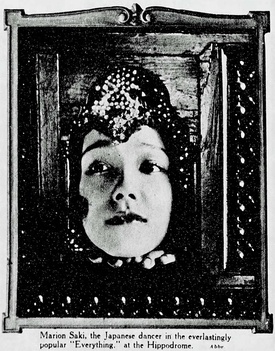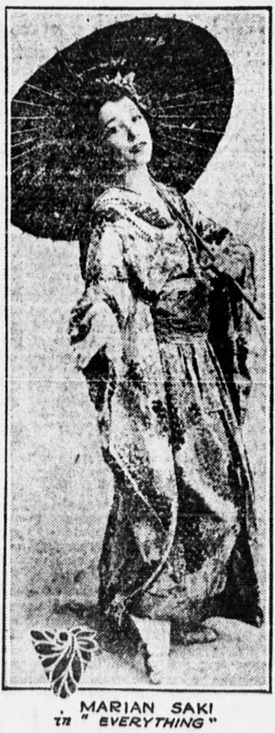A wide selection of Nisei women made their mark as entertainers, in diverse eras and areas of show business: dance, concert halls, opera, theater, and cinema. Arguably the first female star, and surely the most mysterious, was the multitalented Marion Saki (sometimes known as Marian Saki), a ballerina turned Broadway song and dance star of the 1920s, who reinvented herself as a club and concert singer in the 1930s.
When it comes to Saki’s origins and background, nothing is entirely clear. What seems most certain is that her father George Saki was born in Japan circa 1873 and came to the United States in the 1890s. He married Anna Olson in Brooklyn in 1900, and died in September 1920. The 1910 census lists the Saki family as living in Lakewood, New Jersey, where they were employed as servants in the house of a white family, and with two children, Marion and her younger brother Archie. A 1915 New Jersey state census lists Marion Saki as born in 1903, and living in Lakewood. The 1920 census lists the family (all identified as white) as living in New York City. In the 1930 census, Marion Saki is described as 23 years old, and living alone with her mother Annette Olson, a widow of Swedish and Canadian parents.
In her European travel declaration in 1926-27, Saki claimed a birthdate of January 27, 1905. When Saki went on a Caribbean cruise in 1938, she claimed to be 25 years old. Marion Saki’s own statements about her life were as contradictory and questionable as her census forms. In multiple interviews, Saki claimed to have been born in Japan as Hatsuyo or Hatsuko Sakakibara, the mixed-race daughter of Japanese dancer Gitsuo Sakakibara, and to have arrived in the United States aged four years old.
Whatever the dispute over her origins, the sources agree that Saki’s big break came as a teenager, when she was invited to study ballet at a free dance school organized at New York’s Hippodrome by legendary ballerina Anna Pavlova. A newspaper account asserted that Saki, “a little Japanese girl of 605 West 181st Street,” was the daughter of a man who had been a famous dancer in Japan, and for that reason was the first candidate selected for the school. A feature on Saki in the April 1918 issue of the magazine Green Book refers to her as Pavlova’s favorite pupil, and an important dancer in the ballet “Cheer Up.”
The first record of Saki’s dance performance dates from December 1916, when she did a Japanese toe-dance at a charity benefit at New York’s Biltmore Hotel. A few months later, in April 1917, she danced a “swan song” (her teacher Pavlova’s signature dance) at a charity event in Lakewood, New Jersey. In October 1917, she was included in “The Land of Liberty,” a Columbus Day tableau produced by Charles Dillingham at the Hippodrome, with music by legendary band composer John Philip Sousa. The New York Sun commented that Saki’s inclusion in the tableau “was done in the hope of further convincing the mission from the land of Japan of the friendly attitude of this country toward theirs.”
In August 1918, Saki made her smash professional debut at the Hippodrome, when she performed as a Japanese dancer in Everything (1918-9). This mammoth musical spectacle, directed by R. H. Burnside, featured music by Sousa and by Irving Berlin, among others, and appearances by such performers as Harry Houdini and DeWolf Hopper. The show ran for 10 months. In October 1918, Billboard magazine reported that Viscount Kikujiro Ishii, Japanese Ambassador to the USA, attended the show with a director of Tokyo’s Imperial Theatre, who praised Saki’s performance and invited her to dance at his theater.
After Everything closed, Saki moved on quickly, joining the Midwest tour of a Victor Herbert musical, The Velvet Lady. During early 1920, Saki moved to vaudeville, and toured the Keith-Albee circuit in a “tabloid musical revue” featuring Wellington Cross, in which she performed a high-kicking dance. In mid-1920 Saki secured her first large role, as Peggy in the touring company of the musical The Sweetheart Shop. She joined the production in Chicago in Summer 1920, and toured with it throughout the West and Midwest over the following year.
In early 1922 Saki got another professional break when she was engaged by the peerless showman George M. Cohan. Cohan put her on tour with the Otto Harbach musical The O’Brien Girl, which he produced, then brought her back to Broadway in the role of Marie Langford in the musical Little Nellie Kelly, with book, music and lyrics by Cohan. The musical was a smash success. After the Broadway run, she toured with it over the following year, with performances in Washington, Chicago and elsewhere.
Through these plays, Saki became known as a performer. The Daily News referred to her as a “piquant and talented Japanese-American dancer.” The Brooklyn Times Union referred to her as “That dainty Dresden china doll who sang and danced her way to popularity.” With such popularity, she could secure larger roles. Her next notable turn was as Ruth Kingsley in the 1924 musical Plain Jane. When she went to Washington in a tryout tour, Washington Star columnist Wood Soanes made a friendly joke on her name:
“In the cast of Plain Jane there is a girl who is one-fourth Japanese and proud of it. Originally she called herself Marion Saki but now we are informed that she is using her full name Marion Sakytonato (sic). This will set her lineage definitely as of the samurai and at the same time comply with the Eighteenth Amendment [i.e. Prohibition] about moving liquors….”
Plain Jane opened in New York in May 1924. It played on Broadway for several months, then went on the road, touring Chicago and the Midwest during 1924-5. After it folded, Saki returned to Vaudeville and played the famous Palace Theater in New York, as part of an act with the team of Nelson Snow and Charles Columbus. She found the rough-and-tumble climate of Vaudeville difficult, and was temporarily sidelined in July with a broken rib.
In fall 1925 she was featured in a short-lived show, Some Day, that played in Brooklyn. Shortly after it closed, Saki was tapped for her first and only starring role on Broadway, in a show called Sweetheart Time. It opened in January 1926 and played five months. She then joined a touring production of another musical, Honey Girl. Wood Soanes complained that her role in Honey Girl was too small: “Marion Saki, who can sing, dance, and fill the eye, does so not frequently enough.”
In late 1926 Saki was recruited to travel to London to star in Happy Go Lucky, an adaptation of the 1925 US musical When You Smile. Two of the dances Saki did from the show with costar Billy Taylor were recorded on silent film by British Pathé and shown in cinemas. Upon her return to the United States, Saki returned to the Palace Theater for another engagement with the team of Nelson Snow and Charles Columbus.
In 1927, Saki achieved her greatest success. She signed as an understudy to Louise Groody, the leading lady in composer Vincent Youmans’s musical Hit the Deck, (which would later be transformed into an MGM screen musical). Youmans quickly put together a North American touring company, with Saki as the headliner. She barnstormed for a year and a half with the show. When the show opened in Winnipeg in November 1928, The Jewish Post exulted over Saki as, “A beautiful young woman who can sing, dance, and act in such a way that she held New York and London captive in this same musical comedy for a year each.”
It was around this time, in August 1928, that Saki had a serious career setback. According to newspaper reports, she was engaged to play a supporting role in the Marx Brothers comedy Animal Crackers. However, Saki seems to have either left the show during its out-of-town run or been discharged, as she was not among the final Broadway cast. The play would have a long theatrical run before being transformed into a classic film featuring most of the original cast. Instead, Saki was tapped for a supporting role of Sue in the short-lived musical Polly (1929), which featured future radio comedian Fred Allen (during its out-of-town run, the cast also boasted Archie Leach, the future movie star Cary Grant).
After the demise of Polly, Saki faced a career crossroads. With the advent of talking pictures and the Great Depression, Vaudeville and the Broadway musical were in decline. Around this time, she began studying voice seriously, hoping to move into opera—Saki said she dreamed of singing in Madama Butterfly. Saki had a cabaret engagement in 1930 at the International Club, then sang for several weeks in 1930-31 at the Hollywood Cabaret in New York. In 1932, she made a 78 recording of the song “Morning and Evening Comes my Love for You.”
At the end of 1932, she was engaged to perform the supporting role of Mi in a production of Franz Léhar’s operetta The Land of Smiles, starring Charles Hackett. The production was not a success, and never reached Broadway. Nevertheless, Saki received glowing reviews from the New York Times, whose critic noted that she had led the audience to applaud because she “brought a light touch and a lively spirit into far too solemn a [group] performance.”
In Spring 1933, after The Land of Smiles closed, Saki was hired to do a weekly singing program on WMCA radio. The show lasted three months, then was cancelled. After the demise of her radio show, she lapsed into relative obscurity—her dim prospects underlined by a set of advertisements she placed in a local newspaper for singing or dance pupils. In 1934, she was seriously injured in a Greyhound bus accident, and spent time in the hospital. In August 1935 she had a singing engagement in Philadelphia at the Café Marguery. Two years later, she performed an engagement at the Hotel Summit in Uniontown, Pennsylvania.
In May 1942, at a time of wartime anti-Japanese hostility, Saki performed at a benefit concert in New York under the name “Marion (Saki) Huntington” (a surname previously assumed by her brother Archer S. Huntington). It was her last recorded public appearance. The rest of her life is unclear.
Marion Saki’s intriguing stage career helps complicate our understanding of public images of Japanese Americans in the early 20th century. Saki got her start as a “Japanese Pavlova” doing “Japanese” ballet, and through her career was identified (and identified herself) as Japanese American. Her Japaneseness even formed part of her mystique, as she claimed (dubiously) to be Japan-born. Yet she was able to play non-Asian parts on the Broadway stage and in nationwide touring companies without stirring controversy, and while she was described as a “Dresden china doll,” she was not exoticized the way more “oriental” performers were.
Although Saki assumed her Japanese identity and used her real name, she remained distant from ethnic communities. Her name was hardly ever cited in the West Coast Nisei press and she did not perform within the community (in 1917 a report appeared in the New York Times that the Nippon Club planned to host a dancing exhibition by Saki and famed modern dancer Michio Ito, but it is unknown whether such an event ever took place). It was only when she moved into a concert career, with the hope of singing the lead role in Madama Butterfly, that she was cast in an Asiatic role in The Land of Smiles. It is unknowable whether Saki’s Japanese ethnicity prevented her from having a career in Hollywood, but to be able to display her gifts for acting, singing and dance on the Broadway stage must be reckoned a major accomplishment for a woman of that era.
© 2021 Greg Robinson








